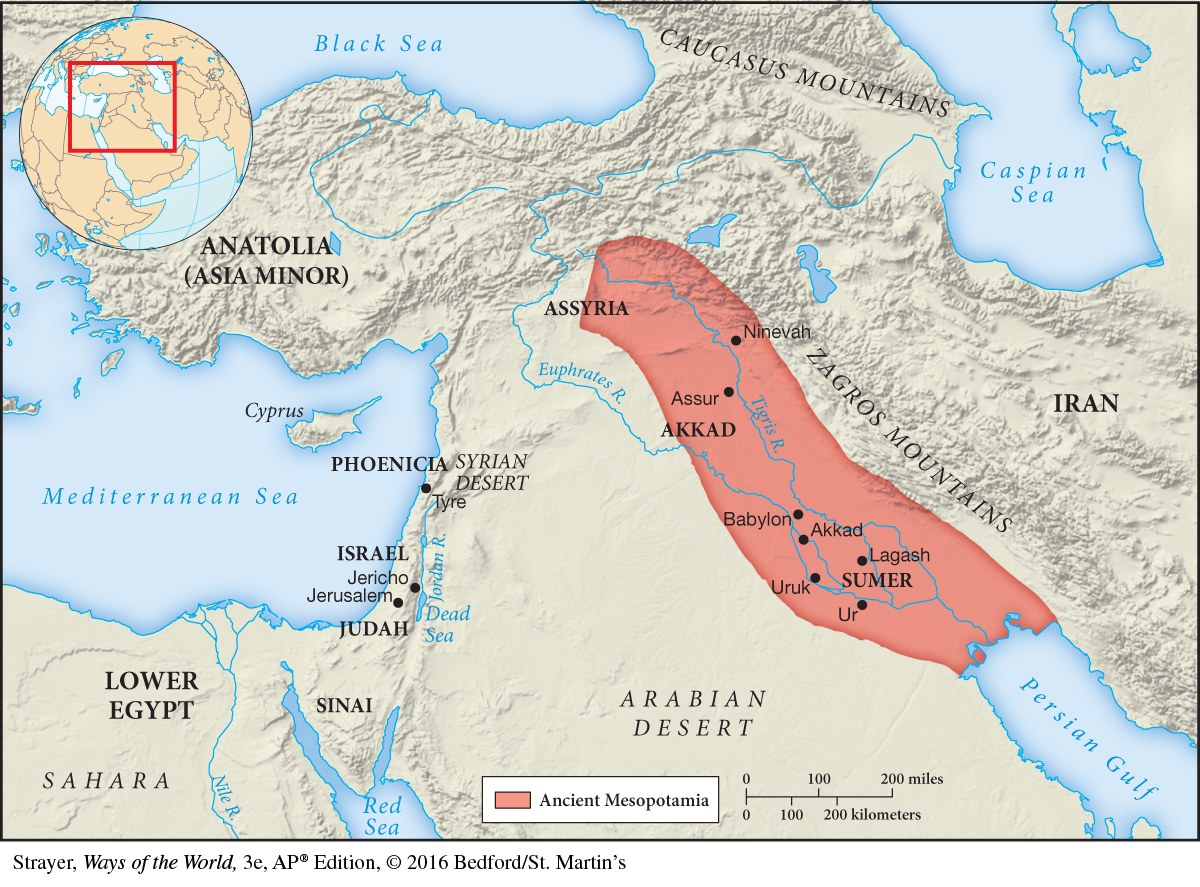Environment and Culture
Guided Reading Question
▪COMPARISON
In what ways did Mesopotamian and Egyptian civilizations differ from each other?
The civilizations of both Mesopotamia and Egypt grew up in river valleys and depended on their rivers to sustain a productive agriculture in otherwise-

But does the physical environment shape the human cultures that develop within it? Most historians are reluctant to endorse any kind of determinism, especially one suggesting that “geography is destiny,” but in the case of Mesopotamia and Egypt, it is hard to deny some relationship between the physical setting and culture.
AP® EXAM TIP
The interactions between humans and the physical environments in which they lived are featured throughout this course.
Mesopotamia’s location within a precarious, unpredictable, and often-
By contrast, elite literate culture in Egypt, developing in a more stable, predictable, and beneficent environment, produced a rather more cheerful and hopeful outlook on the world. The rebirth of the sun every day and of the river every year seemed to assure Egyptians that life would prevail over death. The amazing pyramids, constructed during Egypt’s Old Kingdom (2663–2195 B.C.E.), reflected the firm belief that at least the pharaohs and other high-ranking people could successfully make the journey to eternal life in the Land of the West. Incantations for the dead describe an afterlife of abundance and tranquillity that Gilgamesh could only have envied. Over time, larger groups of people, beyond the pharaoh and his entourage, came to believe that they too could gain access to the afterlife if they followed proper procedures and lived a morally upright life. Thus Egyptian civilization not only affirmed the possibility of eternal life but also expanded access to it.
AP® EXAM TIP
The Epic of Gilgamesh is an important example of early written stories.
If the different environments of Mesopotamia and Egypt shaped their societies and cultures, those civilizations, with their mounting populations and growing demand for resources, likewise had an impact on the environment.18 The Epic of Gilgamesh inscribed in mythology the deforestation of Mesopotamia. When the ruler Gilgamesh sought to make for himself “a name that endures” by building walls, ramparts, and temples, he required much timber. But to acquire it, he had first to kill Humbaba, appointed by the gods to guard the forests. The epic describes what happened next: “Then there followed confusion…. Now the mountains were moved and all the hills, for the guardian of the forest was killed. They attacked the cedars…. So they pressed on into the forest … and while Gilgamesh felled the first of the trees of the forest, Enkidu [the friend of Gilgamesh] cleared their roots as far as the banks of Euphrates.”19
In Sumer (southern Mesopotamia), such deforestation and the soil erosion that followed from it sharply decreased crop yields between 2400 and 1700 B.C.E. Also contributing to this disaster was the increasing salinization of the soil, a long-term outcome of intensive irrigation. By 2000 B.C.E., there were reports that “the earth turned white” as salt accumulated in the soil. As a result, wheat was largely replaced by barley, which is far more tolerant of salty conditions. This ecological deterioration clearly weakened Sumerian city-states, facilitated their conquest by foreigners, and shifted the center of Mesopotamian civilization permanently to the north.
Egypt, by contrast, created a more sustainable agricultural system, which lasted for thousands of years and contributed to the remarkable continuity of its civilization. Whereas Sumerian irrigation involved a complex and artificial network of canals and dikes that led to the salinization of the soil, its Egyptian counterpart was much less intrusive, simply regulating the natural flow of the Nile. Such a system avoided the problem of salty soils, allowing Egyptian agriculture to emphasize wheat production, but it depended on the general regularity and relative gentleness of the Nile’s annual flooding. On occasion, that pattern was interrupted, with serious consequences for Egyptian society. An extended period of low floods between 2250 and 1950 B.C.E. led to sharply reduced agricultural output, large-scale starvation, the loss of livestock, and, consequently, social upheaval and political disruption. Nonetheless, Egypt’s ability to work with its more favorable natural environment enabled a degree of stability and continuity that proved impossible in Sumer, where human action intruded more heavily into a less benevolent natural setting.